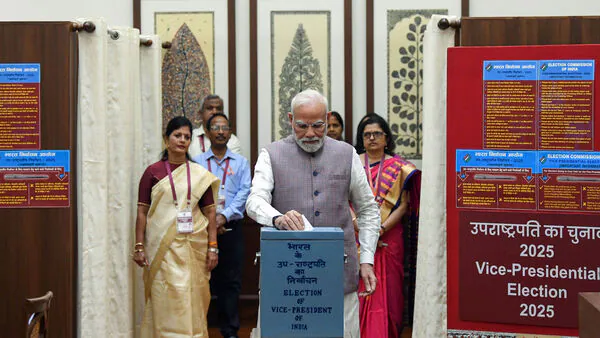CP Radhakrishnan Vs Sudershan Reddy: Why Evms Are Still Not Used In India's Vice Presidential Elections
"...BJP and the PM should tell us that if the Vice President election can take place on the ballot paper, then why not the election of MPs and MLAs. If Zilla Parishad election can take place on a ballot paper, then why not the election of MPs and MLAs,” Surjewala told news agency ANI, echoing earlier demands from Opposition parties of holding assembly and Lok Sabha polls using ballot papers, as was done before.
How is the Vice President of India elected in India?Members of both Houses of Parliament are voters in the Vice Presidential elections.
Also Read | VP Election 2025 LIVE: Voting to pick new Vice President underwayThe MPs are handed out ballot papers containing the names of the two contesting candidates, and they mark their preference by writing the figure '1' opposite the name of the candidate of their choice.
EVMs, which have so far been used in five Lok Sabha and over 130 assembly elections, cannot be used in presidential, vice presidential, Rajya Sabha and state legislative council elections.
Why? Simply because the machines, in use since 2004, are designed to work as vote aggregators in direct elections such as the Lok Sabha and state assemblies. Voters press the button against the name of the candidate of their choice, and the one who bags the maximum number of votes is declared elected.
Single Transferable VoteHowever, the presidential and vice presidential elections are held in accordance with the system of proportional representation , which uses a single transferable vote.
Under the system of proportional representation by means of single transferable vote, every voter (an MP in case of VP polls) can mark as many preferences as there are candidates contesting the election.
Also Read | Vice Presidential polls: How do the numbers stack up?The elector is to mark these preferences for the candidates by placing the figures 1, 2, 3, 4, 5, and so on against the names of the candidates in order of preference in the space provided in column 2 of the ballot paper.
The National Democratic Alliance's (NDA) CP Radhakrishnan and the Opposition INDIA bloc's B Sudershan Reddy are the two candidates in the election for the second-highest constitutional position was necessitated by Jagdeep Dhankhar's sudden resignation on 21 July.
Like the Rajya Sabha elections, voting and counting are held on the same day in the election to the vice president's office.
The EVMs are not designed to register this voting system; they are an aggregator of votes. Under the system of proportional representation, the machine will have to compute votes based on preference, which requires an altogether different technology.
In other words, a different type of EVM would be needed.
According to the Election Commission (EC) website, the EVM was first conceived in 1977 in the poll body, and the Electronics Corporation of India Ltd. (ECIL , Hyderabad, was tasked with designing and developing it.
Prototype in 1979In 1979, a prototype was developed, which the EC demonstrated before political party representatives on 6 August 1980. Once a broad consensus was reached on their introduction, Bharat Electronics Ltd , Bengaluru, another public-sector undertaking, was co-opted along with the ECIL to manufacture EVMs.
Also Read | Vice Presidential polls today: Radhakrishnan vs Reddy as NDA eyes a clear winThe machines were first used in the May 1982 Kerala assembly elections. However, the absence of a specific law prescribing their use led to the Supreme Court striking down that election.
EVMs in general elections since 1998In 1989, Parliament amended the Representation of the People Act, 195 , to create a provision for the use of EVMs in elections.
A general consensus was reached in 1998 on the introduction of EVMs, which were used in 25 assembly constituencies in Madhya Pradesh, Rajasthan, and Delhi.
In the assembly elections held in May 2001 in Tamil Nadu, Kerala, Puducherry, and West Bengal, the EVMs were used in all the assembly constituencies.
If the Vice President election can take place on the ballot paper, then why not the election of MPs and MLAs?Since then, the Election Commission has used them for every state election.
(With PTI inputs)
Legal Disclaimer:
MENAFN provides the
information “as is” without warranty of any kind. We do not accept
any responsibility or liability for the accuracy, content, images,
videos, licenses, completeness, legality, or reliability of the information
contained in this article. If you have any complaints or copyright
issues related to this article, kindly contact the provider above.
Most popular stories
Market Research

- United States Lubricants Market Growth Opportunities & Share Dynamics 20252033
- Daytrading Publishes New Study On The Dangers Of AI Tools Used By Traders
- Newcastle United Announce Multi-Year Partnership With Bydfi
- Ecosync & Carboncore Launch Full Stages Refi Infrastructure Linking Carbon Credits With Web3
- Utila Triples Valuation In Six Months As Stablecoin Infrastructure Demand Triggers $22M Extension Round
- From Zero To Crypto Hero In 25 Minutes: Changelly Introduces A Free Gamified Crash Course


















Comments
No comment